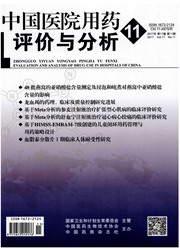

 中文摘要:
中文摘要:
目的:初步探讨医院抗菌药物合理应用的评价方法,以病原微生物耐药率作为评价指标,考察氟喹诺酮类合理应用的可行性,优化医院抗菌药物的应用。方法:对我院2003~2008年6年间氟喹诺酮类药使用情况进行统计分析,结合我院病原微生物的耐药性情况进行评价。结果:总体来说,我院氟喹诺酮类药的应用相对稳定,不同品种的使用频率与细菌耐药情况基本一致。但是发现,药品使用量也与临床对国内外指南的重视程度有关,如受美国感染病学会/美国胸科学会(IDSA/ATS)的CAP指南推荐的影响,近年来莫西沙星的使用率上升,而耐药率逐渐升高的左氧氟沙星使用率有下降趋势。结论:临床应该重视氟喹诺酮类药的合理应用,同时要重视普通病房感染病例的细菌耐药性检测,提高送检率,以获得全院关于病原微生物流行病学的全面资料,有利于促进抗感染药的合理应用。
 英文摘要:
英文摘要:
OBJECTIVE: To explore the method for evaluating the rational utilization of antibiotics in hospital,and to discuss the feasibility of rational use of quinolones using bacterial drug resistance as index so as to optimize the use of antibiotics in hospital. METHODS: The utilization of quinolones in our hospital from 2003 to 2008 were statistically analyzed and evaluated based on the data of bacterial drug resistance in our hospital. RESULTS: Generally,the utility of quinolones in our hospital was relative stable,with a conformity noted between the medication frequency of quinolones and the bacterial drug resistance level. However,the consumption amount of quinolones was also associated with the degree of the importance attached to the related guidelines both at home and abroad,for example,influenced by the IDSA/ATS Guidelines on the Management of Community - Acquired Pneumonia in Adults,the consumption of moxifloxacin has been increasing recently while the consumption of levofloxacin has been declining. CONCLUSION: Great importance should be attached to clinical rational use of quinolones as well as the bacterial drug resistance test of cases in general wards so as to increase the bacterial drug resistance test rate and gain the epidemiological data of pathogenic microorganisms in general wards because it is conducive to rational use of anti - infective drugs.
 同期刊论文项目
同期刊论文项目
 同项目期刊论文
同项目期刊论文
 期刊信息
期刊信息
